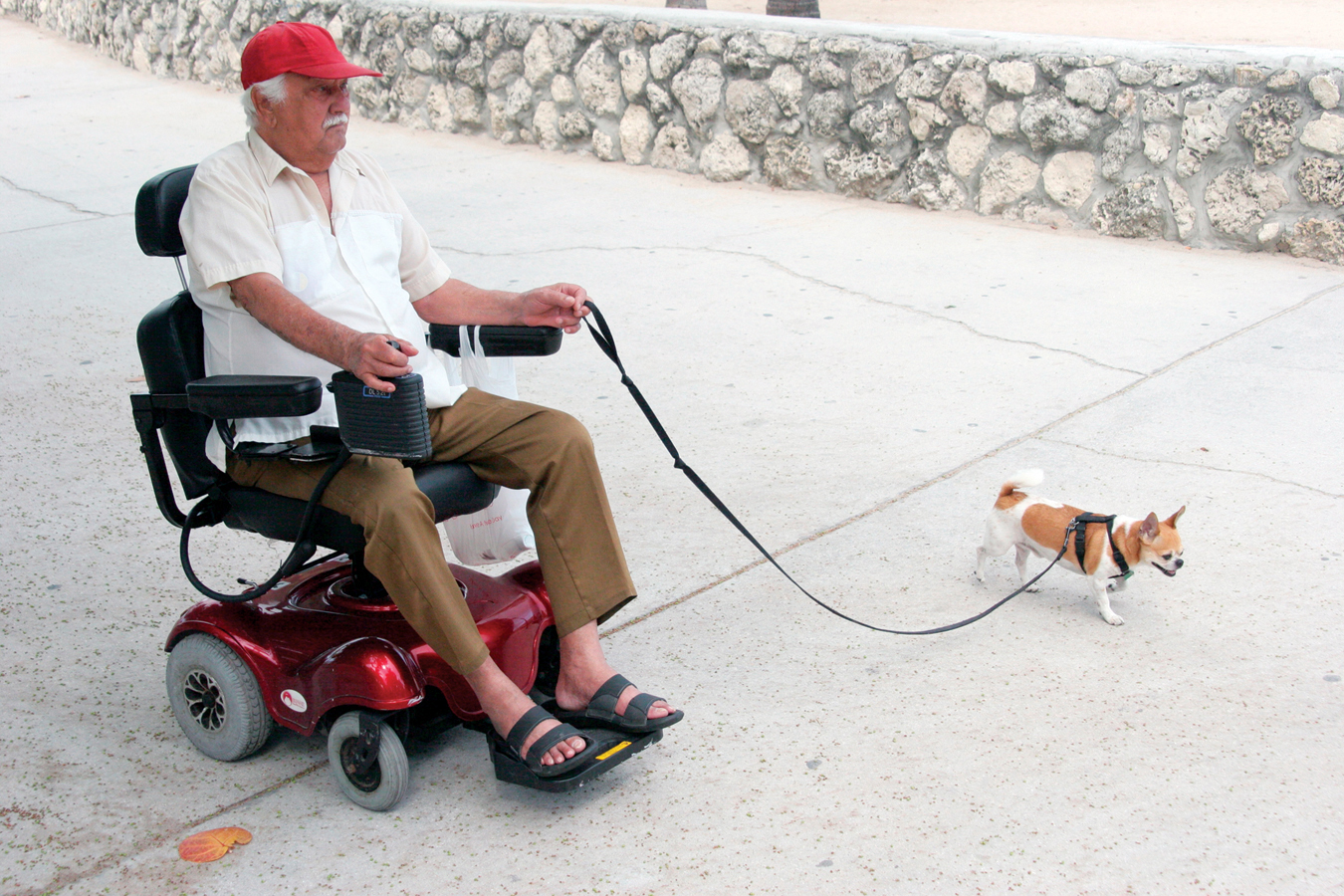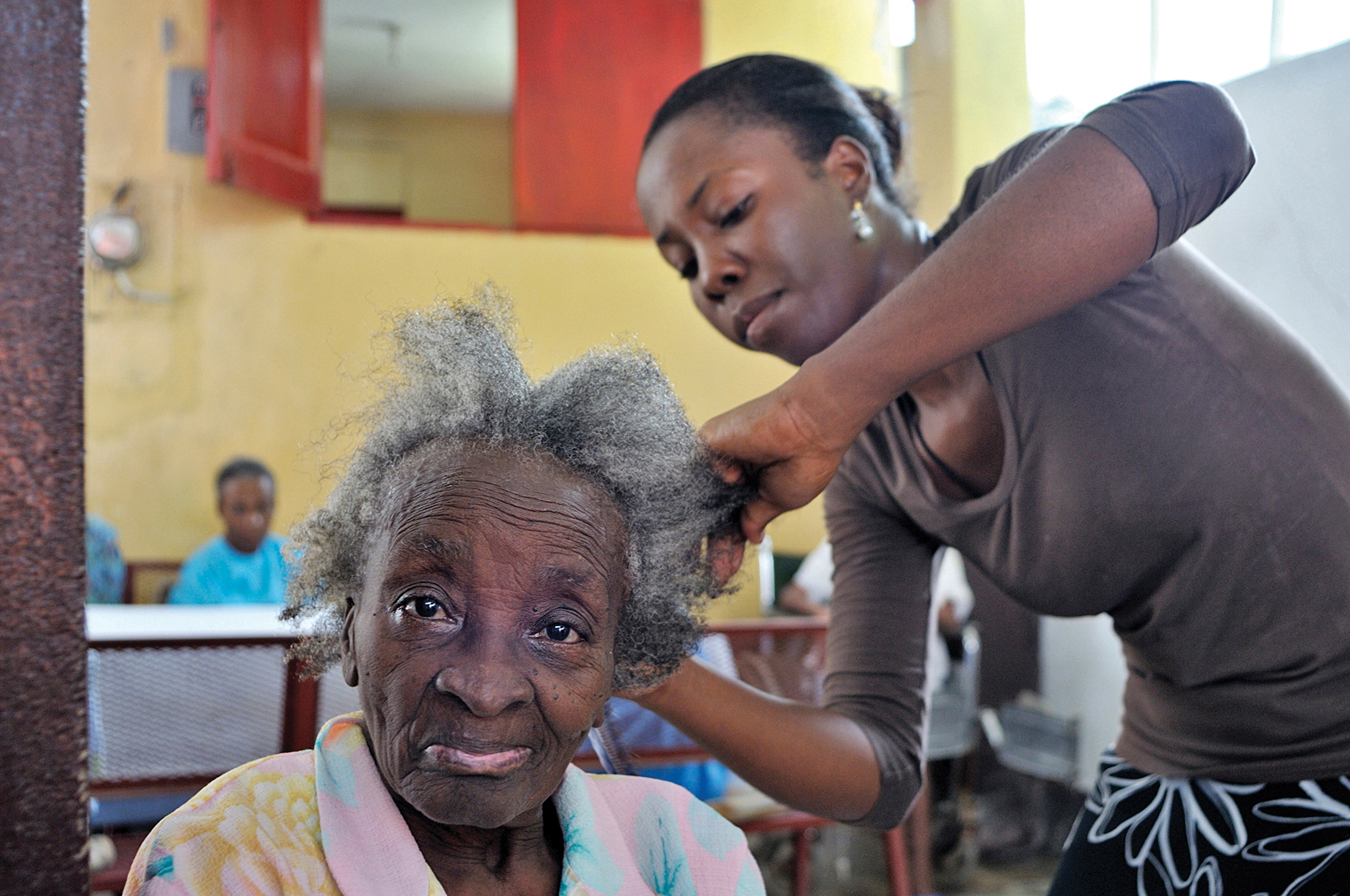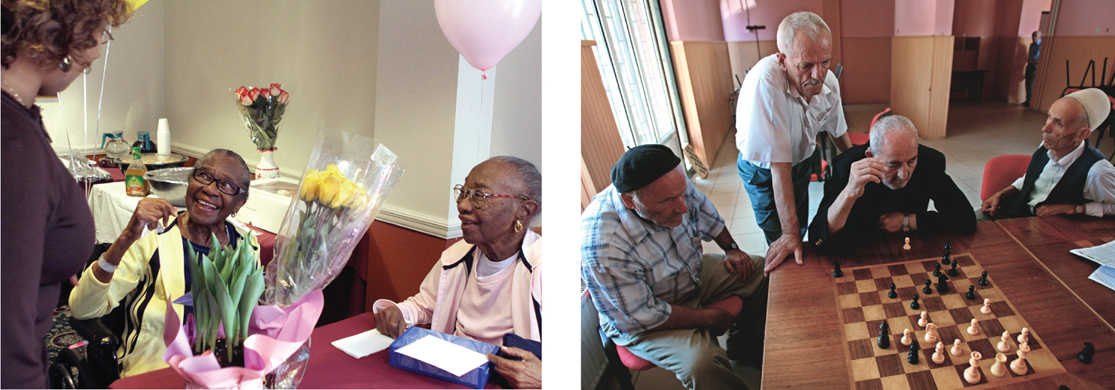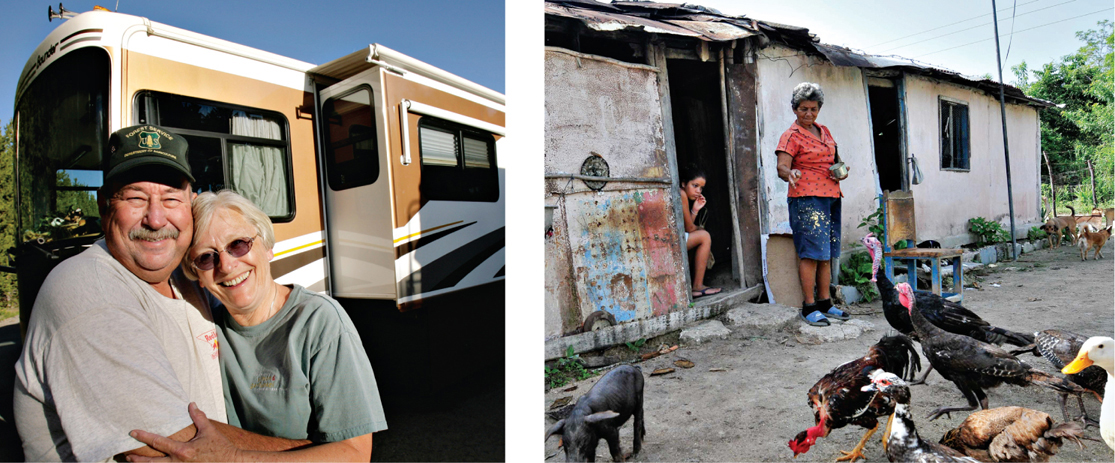25.4 The Frail Elderly
frail elderly People over age 65, and often over age 85, who are physically infirm, very ill, or cognitively disabled.
Now that we have dispelled stereotypes by describing aging adults who are active and enjoy supportive friends and family, we can turn to the frail elderly—
750

Frailty is not defined by any single disease, no matter how serious, but by an overall loss of energy and strength. It is systemic, often accompanied by weight loss and exhaustion.
The frail are not the majority. Typically, older people are happy and active for decades, but eventually about one-
Activities of Daily Life
activities of daily life (ADLs) Typically identified as five tasks of self-
instrumental activities of daily life (IADLs) Actions (for example, paying bills and car maintenance) that are important to independent living and that require some intellectual competence and forethought. The ability to perform these tasks may be even more critical to self-
One way to measure frailty, according to insurance standards and medical professionals, is by assessing a person’s level of difficulty in performing the tasks of self-
IADLs vary from culture to culture. In developed nations, IADLs may include evaluating nutrition, preparing income tax forms, using modern appliances, and keeping appointments (see Table 25.1), although even within developed nations, professionals vary in their lists of IADLs (Chan et al., 2012). In rural areas of developing nations, feeding the chickens, cultivating the garden, mending clothes, getting water from the well, and making dinner might be IADLs.
| DomainManaging medical care |
Exemplar TaskKeeping current on check- |
| Food preparation | Evaluating nutritional information on food labels Preparing and storing food to eliminate spoilage |
| Transportation | Comparing costs of car, taxi, bus, and train Determining quick and safe walking routes |
| Communication | Knowing when and whether to use landline, cell, texting, mail, e- |
| Maintaining household | Following instructions for operating an applianceKeeping safety devices (fire extinguishers, CO2 alarms) active |
| Managing one’s finances | Budgeting future expenses (housing, utilities, etc.) Completing timely income tax returns |
751
Whose Responsibility?
There are marked cultural differences in care for the frail elderly. Many African and Asian cultures hold sons responsible for the care of their parents, and men and their wives take elders into their home, providing meals, medical care, and conversation. Indeed, many couples wanted at least one son in order to have a caregiver when they became old. [Lifespan Link: Sex selection is discussed in Chapter 3.]
Demographics have changed, and that change has an impact on filial responsibility. Some people still romanticize elder care, believing that frail older adults should live with their children, who should care for them. That assumption worked when the demographic pyramid meant that each surviving elder had many descendants, but it does not work for beanpole families.
Now some middle-
A CASE TO STUDY
Preventing Frailty
The best solution is to prevent frailty in the first place, a goal best achieved when individuals, families, and the larger community all do their part. For example, everyone’s leg muscles weaken in old age. That can lead to frailty, or not.
If elders are terrified of falling, they might not walk much. Aging in place might mean staying in a home with steep stairs and a kitchen and bathroom far from the bedroom. Then an overly solicitous caregiver might bring them meals, put a portable toilet in their room, and buy a remote control for their large bedroom TV. The community may contribute to the fear of going outside if sidewalks are lacking and if the TV news highlights violent crime.
To prevent frailty, the individual, the family, and the community could change. The person could exercise daily, walking with family members on pathways built to be safe and pleasant. A physical therapist—
Thus, all three—
A 70-
…He had a lapse of more than five years without proper control of his medical problems [hypertension and diabetes] because of difficulty gaining access to medical care….
Based on the medical history, a cognitive exam,…and a magnetic resonance imaging of the brain,…the diagnosis of moderate Alzheimer disease was made. Treatment with ChEI [cholinesterase inhibitors] was started…. His family noted that his apathy improved and that he was feeling more connected with the environment.
[Griffith & Lopez, 2009]
Both the community (those five years without treatment for hypertension and diabetes) and the family (making excuses, protecting him) contributed to dementia that could have been delayed, if not prevented altogether. The man himself was not blameless. He did not take care of his health, and travelling to Colombia was the worst thing he could have done: Disorientation is worsened in an unfamiliar place. With many types of failing physical and mental health, delay, moderation, and sometimes prevention are possible.
752
Caring for the Frail Elderly
Prevention is best, but not always sufficient. Caregivers themselves are usually elderly, and they are particularly likely to have health problems and inadequate physical strength and immune systems (Lovell & Wetherell, 2011). Thus an aging spouse who cares for the other spouse is likely to need help.
Helping may be harder for a person with failing IADLs than with failing ADLs. After listing the problems and frustrations of caring for someone who is mentally incapacitated but physically strong, the authors of one overview note:
The effects of these stresses on family caregivers can be catastrophic…. They may include increased levels of depression and anxiety as well as higher use of psychotropic medicine such as tranquilizers, poorer self-
[Gitlin et al., 2003, p. 362]
Remember variability, however. Some caregivers feel they are repaying past caregiving, and sometimes everyone else, including the care receiver, expresses appreciation. That relieves resentment, and makes caregiving easier. In fact, a longitudinal study found that when caregivers feel supported by their family, with practical help as well as emotional encouragement, stress diminishes as time goes on—
The designated caregiver of a frail elderly person is chosen less for practical reasons (e.g., the relative with the most patience, time, and skill) than for cultural ones. Currently in the United States, the usual caregiver is the spouse (the wife twice as often as the husband), who often has no prior experience caring for a frail elder.

In northern European nations, most elder care is provided through a social safety net of senior day-
A tradition of caregiving may explain why at least one study found that caregiving African Americans are less depressed than caregivers of other ethnicities (Roth et al., 2008). As always, ethnic generalities may obscure many individual variations: Some caregivers of every group are abusive and depressed; others are uplifted by the role.
Even in ideal circumstances, family members disagree about appropriate nutrition, medical help, and dependence. Public agencies rarely provide services unless a crisis arises. This troubles developmentalists, who study “change over time.” From a life-
If elders require extensive care, ideally skilled people provide it, helping family members to do their part. But many elders themselves are terrified of nursing homes and suspicious of strangers. Since people tend to focus on the worst, most memorable examples of every kind of problem, from complications of pregnancy to the contexts of dying, it is not surprising that people and their families sometimes regard nursing homes as worse than death, and feel shame when a frail person enters one. However, home care can be destructive for everyone.
Elder Abuse
When caregiving results in resentment and social isolation, the risk of depression, poor health, and abuse (of either the frail person or the caregiver) escalates (Smith et al., 2011). Abuse is likely if:
- the caregiver suffers from emotional problems or substance abuse
- the care receiver is frail, confused, and demanding
- the care location is isolated, where visitors are few
753

Ironically, although relatives are less prepared to cope with difficult patients than professionals are, they often provide round-
Extensive public and personal safety nets are needed. Most social workers and medical professionals are suspicious if an elder is unexpectedly quiet, or losing weight, or injured. They are currently “mandated reporters,” which means they must alert the authorities if they believe abuse is occurring. Elder abuse may be financial, yet bankers, lawyers, and investment advisors are not trained to recognize it or obligated to respond (S. L. Jackson & Hafemeister, 2011).
A major problem is awareness: Professionals and relatives alike hesitate to criticize a family caregiver who spends the Social Security check, disrespects the elder, or does not comply with the elder’s demands. At what point is this abuse? Typically, abuse begins gradually and continues for years, unnoticed. Political and legal definitions and remedies are not clear-
About 5 percent of dependent elders say they are abused, and many more are probably abused but ashamed to admit it (Cooper et al., 2008). Accurate incidence data are complicated by definitions: If an elder feels abused, but a caregiver disagrees, who is right? Abused elders are often depressed, ill, and suffering from cognitive disorders, but that neither proves abuse nor absolves abusers (Dong et al., 2011).
Sometimes caregivers become victims, attacked by a confused elderly person. As with other forms of abuse, the dependency of the victim makes prosecution difficult (Mellor & Brownell, 2006). Sometimes secrecy, suspicion, and family pride keep outsiders away. Social isolation makes abuse possible; fear of professionals may makes problems worse.
Long-Term Care
Fortunately, outright abuse is now rare in nursing homes. Laws forbid the use of physical restraints except temporarily in specific, extraordinary circumstances. Some nursing homes provide individualized, humane care, allowing residents to decide what to eat, where to walk, whether to have a pet. In the United States, nursing homes are frequently visited by government inspectors to “stop dreadful things from happening” (Baker, 2007).
In North America good nursing-
The training and the workload of the staff, especially of the aides who provide frequent personal care, are crucial: Such simple tasks as helping a frail person out of bed can be done clumsily, painfully, or skillfully. The difference depends on proficiency, experience, and patience—
Especially for Those Uncertain about Future Careers Would you like to work in a nursing home?
Response for Those Uncertain about Future Careers: Why not? The demand for good workers will obviously increase as the population ages, and the working conditions are likely to improve. An important problem is that the quality of nursing homes varies, so you need to make sure you work in one whose policies incorporate the view that the elderly can be quite capable, social, and independent.
754

VALDRIN XHEMAJ/EPA/NEWSCOM
Quality care is much more labor-
In the United States, the trend over the past 20 years has been toward a lower proportion of those over age 60 residing in nursing homes (in 2011 about 1.3 million people nationwide), and those few are usually over 80 years old, frail and confused, with several medical problems (Moore et al., 2012).
Another trend is toward smaller nursing homes with more individualized care and nurses and aides who work more closely together, especially in homes designated as Eden Alternative or Green, named after exemplars that stress individual autonomy (Sharkey et al., 2011).
Although 90 percent of elders are independent and live in the community at any given moment, half of them will need some nursing-
Alternative Care
An ageist stereotype is that older people are either completely capable of self-
Once that is understood a range of options can be envisioned. Remember the study cited in Chapter 24 that found that dementia is less common in England than it used to be? That study also found that the percentage of people with neurocognitive disorders in nursing homes has risen, from 56 percent in 1991 to 65 percent in 2011, primarily because of a rise in the number of oldest-
That means that more British elderly who need some care are now in the community. This is good news for the elderly, for developmentalists, and for the community, because aging in place, assisted living, and other options are less costly and more individualized than institutions.
The number of assisted-
755

STR/AFP/GETTY IMAGES
Assisted-
Another form of elder care is sometimes called village care. Although not really a village, it is so named because of the African proverb, “It takes a whole village to raise a child.” In village care, elderly people who live near each other pool their resources, staying in their homes but also getting special assistance when they need it. Such communities require that the elderly contribute financially and that they be relatively competent, so village care is not suited for everyone. However, for some it is ideal (Scharlach et al., 2012).
Another option is for elders to remain at home or at a home of a family member. While these arrangements can be rewarding for the caregiver, they can also be stressful. Caregivers, and the elders they care for, often benefit from respite care. For example, the caregivers may get a temporary break when the care receiver has a short stay in an assisted-
Overall, as with many other aspects of aging, the emphasis in living arrangements is on selective optimization with compensation. Elders need settings that allow them to be safe, social, and respected, and as independent as possible. Housing solutions vary depending not only on ADLs and IADLs, but also the elder’s personality and social network of family and friends. One expert explains: “There is no one-
756
We close with an example of family care and nursing-
Fortunately, this nursing home did not assume that decline is always a sign of “final failing.” (Rob’s phrase). The doctors discovered that her pacemaker was not working properly. Rob tells what happened next:
We were very concerned to have her undergo surgery at her age, but we finally agreed…. Soon she was back to being herself, a strong, spirited, energetic, independent woman. It was the pacemaker that was wearing out, not Great-
[quoted in L. P. Adler, 1995, p. 242]
This story contains a lesson repeated throughout this book. Whenever a toddler does not talk, a preschooler grabs a toy, a teenager gets drunk, an emerging adult takes risks, an adult seeks divorce, or an older person becomes frail, it is easy to conclude that this is normal. Indeed, each of these possible problems is common at the ages mentioned and may be appropriate and acceptable for some individuals.
But none should simply be accepted without question. Any one of these should alert people to encourage talking, sharing, moderation, caution, communication, or self-
SUMMING UP
The frail elderly are weak, tired, and fading in many ways. They are unable or unwilling to perform activities of daily life (ADLs) such as feeding, dressing, and bathing themselves, or to carry out the instrumental activities of daily life (IADLs) that require some intellectual competence. Families, communities, and the elderly themselves can postpone or prevent frailty, although they often do not.
Caregiving of the frail elderly can be depressing or satisfying, depending partly on support from professionals, family members, and the care receiver. Help is needed from many people; elder abuse is common—
757